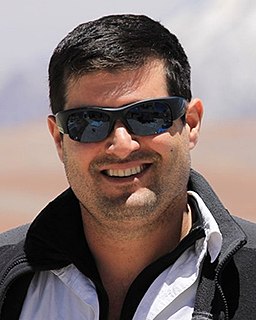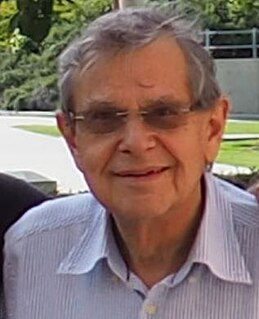Related Research Articles
Geoffrey Ronald Burbidge FRS (24 September 1925 – 26 January 2010) was an English astronomy professor and theoretical astrophysicist, most recently at the University of California, San Diego. He was married to astrophysicist Margaret Burbidge and was one of the authors of the influential B2FH paper.

Eugene Newman Parker was an American solar physicist and plasma physicist. In the 1950s he proposed the existence of the solar wind and that the magnetic field in the outer Solar System would be in the shape of a Parker spiral, predictions that were later confirmed by spacecraft measurements. In 1987, Parker proposed the existence of nanoflares, a leading candidate to explain the coronal heating problem.
Alastair G. W. Cameron was an American-Canadian astrophysicist and space scientist who was an eminent staff member of the Astronomy department of Harvard University. He was one of the founders of the field of nuclear astrophysics, advanced the theory that the Moon was created by the giant impact of a Mars-sized object with the early Earth, and was an early adopter of computer technology in astrophysics.

Feryal Özel is a Turkish-American astrophysicist born in Istanbul, Turkey, specializing in the physics of compact objects and high energy astrophysical phenomena. As of 2020, Özel is a professor at the University of Arizona in Tucson, in the Astronomy Department and Steward Observatory.
Charles F. Kennel is an American plasma physicist and former Associate Administrator of NASA. He is an elected member of the National Academy of Sciences and won the James Clerk Maxwell Prize for Plasma Physics in 1997. In 2009, he was advertised by NASA Watch as a potential pick by Barack Obama as the next NASA Administrator.

Padma Kant Shukla was a distinguished pProfessor and first International Chair of the Physics and Astronomy Department of Ruhr-University Bochum in Germany. He was also the director of the International Centre for Advanced Studies in Physical Sciences at Ruhr-University Bochum. He held a Ph.D. in Physics from Banaras Hindu University in Varanasi, India and a second doctorate in Theoretical Plasma Physics from Umeå University in Sweden.
Francis F. Chen is a Chinese-born American plasma physicist.

Margaret Galland Kivelson is an American space physicist, planetary scientist, and Distinguished Professor Emerita of Space Physics at the University of California, Los Angeles. From 2010 to the present, concurrent with her appointment at UCLA, Kivelson has been a research scientist and scholar at the University of Michigan. Her primary research interests include the magnetospheres of Earth, Jupiter, and Saturn. Recent research has also focused on Jupiter's Galilean moons. She was the Principal Investigator for the magnetometer on the Galileo Orbiter that acquired data in Jupiter's magnetosphere for eight years and a Co-Investigator on the FGM (magnetometer) of the earth-orbiting NASA-ESA Cluster mission. She is actively involved as a Co-Investigator on NASA's Themis mission, the magnetometer Team Leader for NASA's Europa Clipper Mission, as a member of the Cassini magnetometer team, and as a participant in the magnetometer team for the European JUICE mission to Jupiter. Kivelson has published over 350 research papers and is co-editor of a widely used textbook on space physics.
Patrick Thaddeus was an American professor and the Robert Wheeler Willson Professor of Applied Astronomy Emeritus at Harvard University. He is best known for mapping carbon monoxide in the Milky Way galaxy and was responsible for the construction of the CfA 1.2 m Millimeter-Wave Telescope.

Dr. Martin C. Weisskopf is project scientist for NASA's Chandra X-ray Observatory and Chief Scientist for X-ray Astronomy in the Space Sciences Department at NASA's Marshall Space Flight Center in Huntsville, Alabama.

Brian Gregory Keating is an American cosmologist. He works on observations of the cosmic microwave background, leading the BICEP, POLARBEAR2 and Simons Array experiments. He received his PhD in 2000, and is a Distinguished Professor of Physics at University of California, San Diego since 2019. He is the author of two books, Losing The Nobel Prize and Into the Impossible.

Forman Arthur Williams is an American academic in the field of combustion and aerospace engineering who is Emeritus Professor of Mechanical and Aerospace Engineering at the University of California San Diego.
Richard Emery "Rich" Lingenfelter was an American astrophysicist and historian. He is known for his work on the origin of cosmic rays and gamma rays. As a historian, he is recognized for his efforts at chronicling the history of Death Valley.
Tihiro Ohkawa was a Japanese physicist whose field of work was in plasma physics and fusion power. He was a pioneer in developing ways to generate electricity by nuclear fusion when he worked at General Atomics. Ohkawa died September 27, 2014 in La Jolla, California at the age of 86.
Thomas Michael O'Neil is an American physicist who specializes in plasma physics.
Patrick Henry Diamond is an American theoretical plasma physicist. He is currently a professor at the University of California, San Diego, and a director of the Fusion Theory Institute at the National Fusion Research Institute in Daejeon, South Korea, where the KSTAR Tokamak is operated.
Edward E. Thomas Jr. is an American plasma physicist and a Professor of Physics at Auburn University. He currently serves as the university's associate dean for research and graduate studies and is also the university's Charles W. Barkley Endowed Professor for diversity and inclusion. He is a fellow of the National Society of Black Physicists (2011), the Alabama Academy of Sciences (2012) and the American Physical Society (2015).
Barbara Wayne Abraham-Shrauner is an American physicist, applied mathematician, and electrical engineer, known for her research on magnetohydrodynamics and plasma phenomena, including mathematical modeling of shocks and Alfvén waves, observation of the solar wind, and applications to the plasma etching of semiconductors, as well as on hidden symmetries and nonlocal symmetries in differential equations. She is retired as a professor of electrical and systems engineering at Washington University in St. Louis.
Lucy Frear Fortson is an American astronomer known for her work on gamma-ray astronomy and Galaxy morphological classification and for her leadership of citizen science projects including the Galaxy Zoo and Zooniverse. She is a professor in the School of Physics and Astronomy at the University of Minnesota.
Merav Opher is a professor of Astronomy at Boston University known for her work on the heliosphere, the cloud around the sun. In 2021 she was named a William Bentinck-Smith Fellow at the Harvard Radcliffe Institute.
References
- ↑ Astronomy Alumni, Harvard Astronomy, retrieved 2021-02-03
- ↑ "75: Plasma Physics", Scientific and Technical Aerospace Reports, NASA, 15 (21): 2868–2869, November 8, 1977
- ↑ Applied Plasma Physics and Fusion Energy Seminar Series, Fall 2002, UCSD Mechanical and Aerospace Engineering, retrieved 2021-02-03
- ↑ Marlene Rosenberg, UCSD Center for Astrophysics and Space Sciences, retrieved 2021-02-03
- ↑ "Fellows nominated in 2000 by the Division of Plasma Physics", APS Fellows archive, American Physical Society, retrieved 2021-02-03
- ↑ "Laroussi paper named one of most significant", News @ ODU, Old Dominion University, November 2007, retrieved 2021-02-03
- ↑ "CASPER proposal team awarded NASA/NSF grant for on-orbit dusty plasma research aboard the International Space Station" (PDF), CASPER News, Baylor University, vol. 17, p. 1, 2017